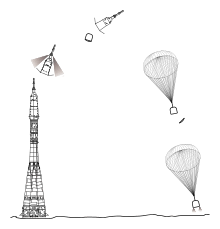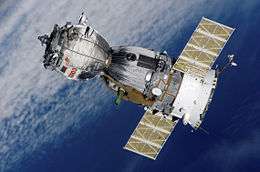Soyuz abort modes
In the event of catastrophic failure, the Soyuz spacecraft has a series of automated and semi-automated abort modes to rescue the crew. The abort systems have been refined since the first manned flights and all abort scenarios for the Soyuz TMA-M are expected to be survivable for the crew.[1]
Launch Abort Modes
The Soyuz abort systems are especially complicated because of the modular design of the vehicle; only the middle lander module is designed to survive reentry, so in an emergency the utility module and the lander module must be separated together (sometimes with the service module also attached) before the lander can be separated and orient itself for reentry. Other soviet spacecraft, like the TKS, attempted similar modular designs with a hatch through the heat shield to resolve this issue.[2] The modular design also means that the Soyuz capsule is contained within a payload shroud for much of the flight and removing the shroud without collision in an emergency was another difficult issue that needed to be addressed.[3]
Jettisonable Emergency Escape Head Section

The primary abort system for use early in the flight was the Jettisonable Emergency Escape Head Section, known by its Russian abbreviation OGB SAS or just SAS. It is a launch escape system designed by a team from OKB-1 under Sergei Korolev's leadership.[3] The SAS is a single solid rocket booster with several nozzles to control attitude, placed on top of the Soyuz capsule.[4]
The SAS can be used to separate the Soyuz capsule from the launch vehicle up to about two and half minutes into powered flight. The launch escape system can be triggered by onboard computers or by radio communication from ground crews. The on board computers use instruments to detect several possible failures including premature separation of stages, loss of pressure in combustion chambers, and loss of control of the launch vehicle.[3] Once triggered, struts are deployed to secure the lander module to the utility module until after the escape motors are burnt out and jettisoned. After this, the lander module is separated, its heat shield is jettisoned, and its parachutes are deployed.[1]
Other Abort Procedures
In early Soyuz models there were two abort modes in the time ranging from the ejection of the launch escape system until orbit. One called for separation of only the upper two modules and a controlled descent and could be initiated before about t+522s, the other separated all three and underwent a ballistic descent after t+522.[4]
Unlike the space shuttle, Soyuz cannot abort-to-orbit because its third stage has only a single engine and does not carry the reserve fuel necessary to achieve orbit with reduced thrust at a lower stage.[4]
Reliability
An analysis of the overall reliability of the Soyuz capsule was published in the years leading up to the retirement of the Space Shuttle in 2010 by individuals from NASA JSC and the ARES corporation. The report concluded that the current manned Soyuz capsule has not been on enough flights to reliably measure the probability of a loss of mission, but that overall history of the program show that it performed roughly as reliably as other contemporary systems and that, while the number could be improved, significant improvement of reliability was not feasible with current technology.[5]
Following a malfunction in the central thrust chamber of the launch escape system during the Soyuz TMA-15 mission to the International space station, concerns have been raised by officials with NASA and Russian organizations, like the Machine Building Central Research Institute, about the quality control and reliability of Soyuz emergency systems.[6]
Soyuz abort history
Soyuz spacecraft have successfully prevented the loss of crew with a launch abort twice in its history thus far, though both cases are considered a loss of the mission.[5] The successful launch aborts to date are
- Soyuz 18a, launched 5 April 1975, failed to separate the second and third stages which triggered an automated abort system. The engines on the service module were used to separate the crew from the launch vehicle.[7]
- On 26 September 1983 Soyuz T-10-1 caught fire and the crew was saved by firing its launch escape system. It is, to date, the only successful manned pad abort.[8]
See also
References
- 1 2 "Soyuz TMA-M – Spacecraft & Satellites". spaceflight101.com. Retrieved 28 April 2016.
- ↑ "Soyuz". Encyclopedia Astronautica. www.astronautix.com. Retrieved 3 May 2016.
- 1 2 3 Zak, Anatoly. "Emergency escape system of the Soyuz spacecraft". www.russianspaceweb.com. Retrieved 7 May 2016.
- 1 2 3 Hall, Rex; Shayler, David J. (2003). Soyuz: A Universal Spacecraft. Chichester, UK: Praxis Publishing Ltd. p. 70. ISBN 1-85233-657-9. Retrieved 3 May 2016.
- 1 2 Lutomski, Michael G.; Farnham II, Steven J.; Grant, Warren C. "Estimating the Reliability of a Soyuz Spacecraft Mission" (PDF): 3. Retrieved 7 May 2016.
- ↑ Oberg, James (31 March 2010). "Russians report snag in space safety system". msnbc.com. NBC News. Retrieved 7 May 2016.
- ↑ Shayler, David (2000). Disasters and Accidents in Manned Space Flight. Springer Praxis. p. 159. ISBN 1-85233-225-5.
- ↑ "A brief history of space accidents". Jane's Transport Business News. February 3, 2003. Archived from the original on 2003-02-04. Retrieved 2007-10-20.
